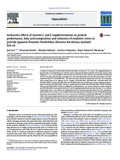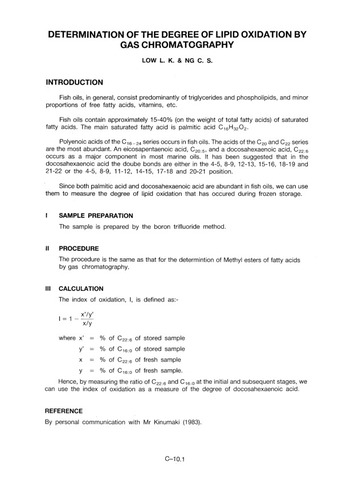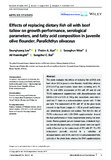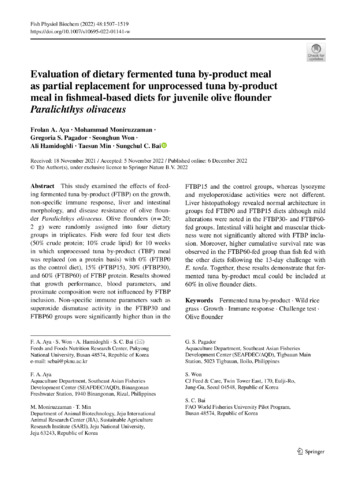Interactive effects of vitamin C and E supplementation on growth performance, fatty acid composition and reduction of oxidative stress in juvenile Japanese flounder Paralichthys olivaceus fed dietary oxidized fish oil
Share
Abstract
A study was conducted to determine the interactive effects of vitamin C (VC) and E (VE) supplementation on growth, fatty acid composition and oxidative status of Japanese flounder juveniles. Fish (initial average body weight of 1.1 ± 0.1 g) in triplicate were fed five test diets for 60 days. Control diet contained fresh fish oil (FFO, 8.9 meq/kg) with 100 mg α-tocopherol (α-Toc) equivalents/kg of VE and 500 mg ascorbic acid (AsA) equivalents/kg of VC (FFO100E/500C). The other four diets contained oxidized fish oil (OFO, 167.8 meq/kg) with varying levels of VE (mg/kg) and VC (mg/kg) (OFO100E/500C, OFO200E/500C, OFO100E/1000C and OFO200E/1000C). Fish fed FFO100E/500C and OFO100E/500C had no differences in body weight gain (BWG). However, fish fed OFO200E/1000C diet had a significantly lower BWG than FFO100E/500C. Fish fed OFO200E/500C and OFO100E/1000C showed no differences in thiobarbituric acid-reactive substance values compared with FFO100E/500C. Increasing the levels of VC and VE supplementation increased liver AsA and α-Toc contents, respectively. Liver α-Toc content was significantly increased with incremental dietary VC levels, indicating a sparing effect of VC on liver α-Toc content of fish. Increasing the levels of dietary VC and VE supplementations decreased concentrations of 20:5n-3, 22:5n-3 and 22:6n-3 in fish liver. Fish fed OFO100E/500C and OFO200E/1000C diets showed higher oxidative stress condition than those fed FFO100E/500C. In conclusion, dietary VC and VE supplementation could maintain normal growth and health condition of juvenile Japanese flounder fed OFO. However, high doses of both vitamin supplements induced fish lipid peroxidation under oxidative stress condition.
Keywords
Paralichthys olivaceus Vitamin C Vitamin E Lipid peroxidation Oxidative stress Fatty acid compositionSuggested Citation
Gao, J., Koshio, S., Ishikawa, M., Yokoyama, S., & Mamauag, R. E. (2014). Interactive effects of vitamin C and E supplementation on growth performance, fatty acid composition and reduction of oxidative stress in juvenile Japanese flounder Paralichthys olivaceus fed dietary oxidized fish oil. Aquaculture , 422–423, 84-90. https://doi.org/10.1016/j.aquaculture.2013.11.031
Subject
Collections
- AQD Journal Articles [1249]
Related items
Showing items related by title, author, creator and subject.
-
Analysis of oils: Determination of the degree of lipid oxidation by gas chromatography
Low, Lai Kim; Ng, Cher Siang (Marine Fisheries Research Department, Southeast Asian Fisheries Development Center, 1987)The paper provides the methodology in the determination of the degree of lipid oxidation by gas chromatography. Instructions on sample preparation and the detailed procedures and calculation are provided. -
Effects of replacing dietary fish oil with beef tallow on growth performance, serological parameters, and fatty acid composition in juvenile olive flounder, Paralichthys olivaceus
Lee, Seunghyung; Aya, Frolan; Won, Seonghun; Hamidoghli, Ali; Bai, Sungchul C. (Wiley, 2020-04)This study evaluated the effects of replacing fish oil (FO) with beef tallow (BT) in juvenile olive flounder, Paralichthys olivaceus (3.93 ± 0.07 g), over 8 weeks. Seven diets, consisting of 0, 25, 50, 75, and 100% replacement ... -
Evaluation of dietary fermented tuna by-product meal as partial replacement for unprocessed tuna by-product meal in fishmeal-based diets for juvenile olive flounder Paralichthys olivaceus
Aya, Frolan; Moniruzzaman, Mohammad; Pagador, Gregoria E.; Won, Seonghun; Hamidoghli, Ali; Min, Taesun; Bai, Sungchul C. (Springer, 2022-12-06)This study examined the effects of feeding fermented tuna by-product (FTBP) on the growth, non-specific immune response, liver and intestinal morphology, and disease resistance of olive flounder Paralichthys olivaceus. ...




